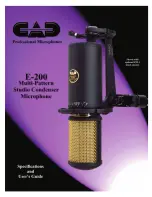
5. Always provide adequate protection for your R-122, or any ribbon microphone. If the
microphone is to remain set up on a stand when not in use, place a “mic sock” (supplied with
every Royer microphone) over it until it is to be used. Do not carry the microphone around
without placing a mic sock over it. Failure to follow this commonsense practice may yield a
stretched ribbon and compromised performance.
6. Do not allow the microphone to be dropped on hard surfaces such as floors or tables -
depending on how the mic falls, you could stretch the ribbon. The microphone would likely
continue to operate, but performance could be compromised and re-ribboning the
microphone would be necessary to restore normal operation.
Amplification Considerations
Almost any microphone preamplifier, with nominal gain characteristics and a built-in 48-volt
phantom power source, will give excellent results with your R-122 active ribbon microphone.
Unlike standard ribbon microphones, which depend on a proper impedance match to deliver
optimal performance, the input impedance of your preamplifier will have minimal affect on the
R-122’s operational performance because the ribbon element is loaded perfectly via the
microphone’s electronics package.
Careful consideration should be given to the quality of the microphone preamplifier. Studio-
grade preamplifiers usually sound much better than cheap ones. Headroom, noise floor,
transparency and coloration are all factors to consider in determining which preamplifier is
suitable for your studio or live sound application. Other features are usually secondary and fall
into the category of conveniences or interface capabilities (such as digital or optical outputs).
A good preamplifier should sound natural, with no sign of edginess or excessive noise. Vacuum
tube preamplifiers sound warm, yet wonderfully airy and transparent. Do not expect a vacuum
tube preamplifier to be as quiet as a solid-state preamp, as electron emissions from tubes tend to
convey more “thermal” noise than transistors. Tube preamplifier noise is far less of an issue with
the R-122 than with conventional ribbon microphones because the R-122’s high output will
override the noise. Transformer coupled designs tend to sound punchy and full-bodied and offer
the added benefit of true electronic isolation. This greatly enhances their ability to interface with
other equipment with minimal noise or hum. There are many excellent preamplifiers on the
market today. Choose one that fits your budget and offers good performance, but remember that
you get what you pay for. If you have the opportunity to audition one or more preamplifiers
before you buy one, do so. Microphones and preamplifiers work together like a team and some
are just better matches than others.
The R-122 active ribbon microphone is capable of substantial output signal, especially if used in
conjunction with very loud signal sources such as guitar amplifiers. It is therefore recommended
that the microphone preamplifier have a switchable pad to prevent the possibility of overloading
the preamplifier’s input stage electronics. Some preamplifiers are more thoughtfully designed
than others, and a suitable pad will be provided before the active electronics, not incorporated
into a “feedback loop” as some cheaper models do. The latter design could still produce
7






































